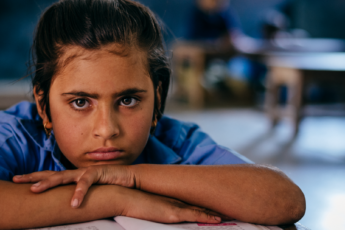Addressing India’s Looming Learning Loss Pandemic
School closures were a bittersweet solution to battle COVID-19. While the intention of this was to stem the spread of the pandemic, recent studies show that it has had alarming consequences for students, who have made little progress after schools closed. In addition, remote learning has significant limitations in the Indian context as students missed out on school resources, social interactions with peers, and learning in a classroom environment, leading to children experiencing learning loss.
Delving into the data reveals that students performed poorly while studying from home, and it was little surprise to see that children in rural areas were most affected. Nearly half of grade school children in India’s rural areas were unable to read more than a few words, and the gap between digital natives and those who live in rural areas continues to widen. It is a matter of concern to see that only 8% of students in rural India regularly accessed online education mediums, while 37% gave up studying entirely.

For many of these children and communities, education is an enabler that gives them the opportunity to improve their life circumstances, and school closures have stymied learning. Given that about half of the households in rural areas have no smartphones, the lack of online learning starts to add up. But even among households that have some kind of digital connectivity, only 15 percent of rural children are studying online regularly, as opposed to 31 percent of urban children.
Although state governments have made considerable efforts to improve internet connectivity, the lack of digital devices and digital literacy have adversely affected remote learning. Moreover, poor governance within government bodies, pre-existing capacity deficits in schools, and lengthy lockdowns have compounded India’s learning lacunae.
Impact of Learning Loss in India
The impact of learning loss in rural areas is more significant as opposed to the loss felt by students in urban areas, where resources are readily available. Moreover, as literacy rates are low and schools remain understaffed, the effects of learning loss in students extend beyond academic outcomes to psychological well-being and social-emotional adjustment.
Almost 1.5 years have elapsed since students learned in proper classrooms. Up to this point, the students in the current class only had minimal learning from the previous grades, and there have been learning regressions, to the extent that they’ve forgotten most of what they learned from the previous grade. Some reports have also shown a decrease in their ability to read with understanding and perform mathematical tasks. These abilities are foundational. Therefore, their absence will impact not only other skills, but also a child’s conceptual understanding beyond the subject area where the deficit occurred.

Surveys have also revealed that over 48% of children in rural India are unable to read even a few words — an indication of the extent of unmet needs of children. These children have lacked necessary learning opportunities due to a growing number of schools that are either shuttered, too far away, or curriculum that doe not match their learning needs.
The prolonged lockout has hurt the education of many children. A significant challenge for children has been attending school and interacting with other students outside their immediate social circle. Given how much parents have been affected by difficult economic conditions, education is often their only hope for their child to have a better life in the future. Parents are eagerly waiting for their children to go back to school. Reopening schools with preventive measures have been all the more imperative to mitigate learning loss due to covid.
To bridge the learning gap caused by school closures, the parliamentary panel has suggested reopening schools with the following measures:
- Conduct vaccination programs for students and school staff
- Conducting classes in two shifts or alternate days to control crowds
- Stepping up preventive measures of maintaining physical distance
- Mandatory wearing a mask and frequent hand sanitization
- Thermal screening to test infected individuals
Along with this, schools should be subjected to frequent inspections by COVID administrators to ensure strict adherence to hygiene, COVID protocols, and facility maintenance. The good news is that many schools are now reopening or planning to reopen, which will help redress educational setbacks.
Mitigating Learning Loss
To help improve the quality of education delivered, it is essential to open schools and invest in tomorrow’s educational standards. We believe that a holistic approach is needed to help alleviate learning loss among students.
- Embracing Public-Private Partnerships (PPPs)
PPPs in education can play a critical role in the Indian context, serving as innovation centres for deepening access to and improving the quality of education. More critically, as they are run in government infrastructure with tightly monitored processes, pre-defined and measurable outcomes, and stringent performance metrics, they are replicable across the board. A Public-Private Partnership offers specific knowledge, expertise, and technological innovations that draws on the best of both worlds to make education affordable, increase accessibility, improve efficiency, and deliver speedy execution for better outcomes.
At Square Panda India, we strategically collaborate with government and impact organizations to create a holistic impact across the education ecosystem by building learning programs, opening learning centres, and creating access to advanced learning tools.
- Upskilling Teachers
The pandemic has caused a pivot to a digital or blended model of education, which neither teachers nor infrastructure is wholly prepared for. Simply put, educators across the nation are at different levels when it comes to technological literacy and competency, and so we need to coach educators on the use and role of technology in driving optimal learning outcomes.
Empowering our teachers, Anganwadi workers, and other educators on the optimal use of technology to deliver an effective education is a must, since they hold the key to unlocking our student’s potential. Only then will it be possible for each student to receive a similar quality of education wherever they are. It is also essential that we focus on improving the digital and human capital infrastructure of government schools, if we are to achieve 100% literacy in India.
- Innovative Solutions
The pandemic has been a double-edged sword for education. Even as it cut short learning years and eroded knowledge bases for students, it caused educators and administrators to move existing classes to a digital medium in order for it to be accessible. This fully remote or blended learning model can maximize student learning, but in order to do so, we will require a research-based understanding of the optimal amount and mix of learning activities for diverse sets of learners.
Blended learning is the right segue for this, allowing students to re-enter classrooms, explore learning material remotely, and ask their queries through a virtual medium, such as websites, email, video, or chatbots. As students get more comfortable in this new normal, the degree of self-paced, asynchronous learning will rise. Connecting the virtual and physical worlds can achieve remarkable outcomes if paired with inclusive, research-derived, and technology-enabled learning models. This is aligned with the objectives of NEP 2020, which looks to embed technology across the education ecosystem through platforms such as DIKSHA/SWAYAM. - Tailored Learning Experiences
Each of us understand that each child is unique, but we don’t often tailor their education to reflect this. By embracing the latest technological advances, such as AI and Machine Learning, to provide personalised learning paths, students can be fully engaged in the learning journey.
Founding education experiences in a data-driven approach has other benefits too. Educators will find that they can tailor curriculum to match a student’s pace of learning; policymakers too can leverage this approach to pursue an evidence based approach to policymaking as well. Doing so can drive improved learning outcomes at scale.
Technology too can be a key lever. For instance, AI allows for the identification and tracking of “knowledge points” that accurately reflect an individual’s “knowledge state” for any given subject. This allows for a world of personalised learning experiences and content formats that deliver essential knowledge as per each student’s unique requirements. Embracing innovations such as these, and more, could be key to building a better, more literate India where everyone reaps the rewards of a world-class education.
Our multifaceted programs help each stakeholder of the Indian Education System – educators, students, Anganwadi workers, and the Government – reach their learning and developmental goals, leveraging technology and data to create replicable and scalable models of intervention. Click here to better understand how we’re creating long-term change centred around the most pressing challenges across India’s education landscape.







Leave a Comment